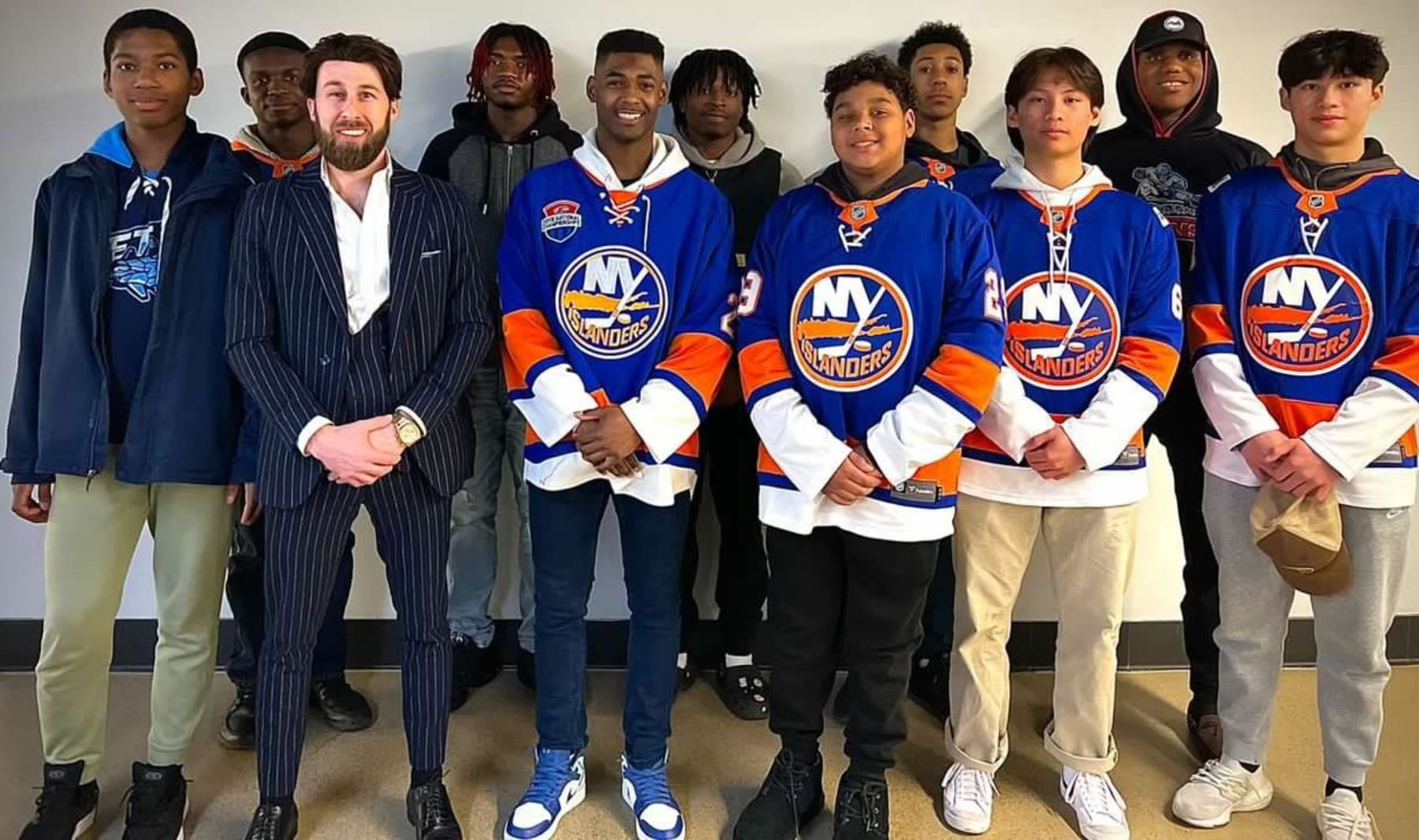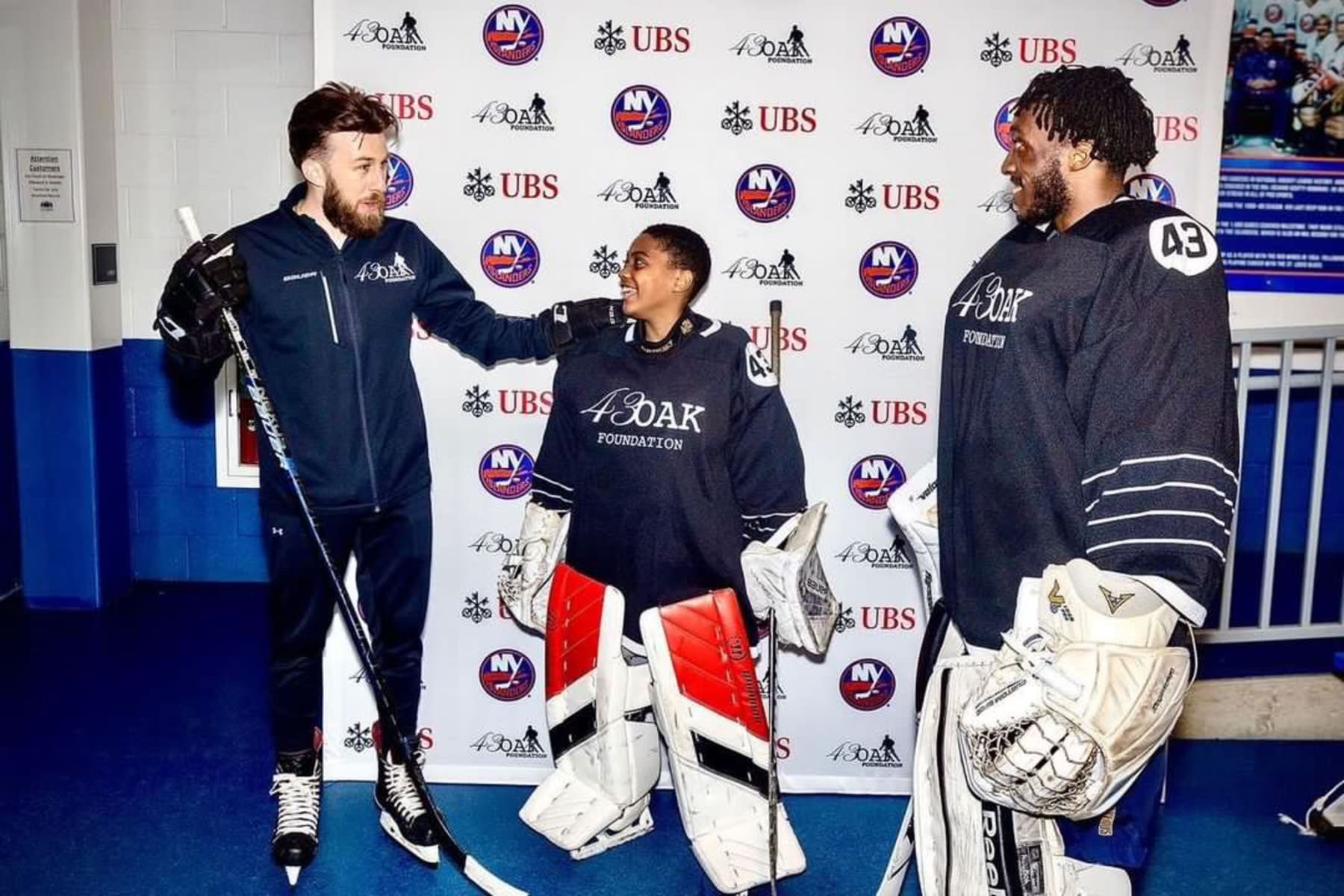How the Islanders & 43 Oak Are Making Hockey Dreams a Reality for Disadvantaged Kids

Editor's Note: Some quotes were shortened for length
There's one conversation that will never get old for 43 Oak founder and CEO Sean Grevy.
"This month, we had a new player enter the program, and his father came up to me after one of our practices the other day," Grevy told Bleacher Report. "You could tell he's a really prideful guy, and he just started to talk then he started to cry. I reached out, gave him a huge hug, and said 'Look man, whatever it is, we've got you. It doesn't have to be like this. You shouldn't have to feel what you're feeling right now.'
"He wipes the tears from his eyes and says, 'I was going to have to tell my kid today that he was going to have to quit Triple-A hockey. I just can't afford it right now. I'm getting crushed.'
"I said, 'Well, good news. You don't have to tell your kid he has to quit anymore.'"
These conversations touch Grevy every time because he remembers his parents tearfully struggling—and sometimes failing—to foot his hockey bills.
He has too many painful memories like this surrounding the sport he loves, like growing up in a Philly neighborhood where youth hockey was non-existent and how it felt to have to venture out of that neighborhood every weekend to get to a rink. It's what led him to spearhead the start of the 43 Oak Foundation.
At its core, the 43 Oak Foundation connects disadvantaged kids to Triple-A hockey teams and pays their way to potentially play the highest level of youth hockey available. It started with six or seven kids, who Grevy financed out of pocket.

He had identified a huge gap in the hockey world—Hockey Is For Everyone and Learn To Play have been a great start in making hockey more accessible, but what comes next for the alumni of those programs?
"You could physically see, when you would leave my neighborhood, the better the neighborhoods would get as you would get closer to the hockey rink," he recalled.
The look on his friends' faces as their parents told them they could never afford for them to "play hockey like Sean" stuck with Grevy for life, even as he moved to New York City as an adult. When he began to find financial success in his career, he also started coaching youth hockey on the side.
He looked around and saw something all too familiar—talented and bright kids from the city who just couldn't afford to play one of the most expensive and inaccessible sports. Then he realized he was finally in a position to help.
It started with Grevy mentoring a handful of kids and financing their hockey journeys, with an emphasis on using hockey as a gateway to college.
"When it first started, it was just really to help these kids, be a mentor and a friend and guide them the best I could," he said. "And as the years went on, I realized there was a carved-out plan of action for these players if they really wanted to go on and further their education through the sport, which is the goal, to get to college and play hockey in college.
"There was a plan. You had to be in a certain place, you had to play Triple-A at a certain age, and how do you do that? Well, through connections in the sport, through mentorship, and also, most importantly, through financial assistance. I don't care how much somebody supports you mentally; if you don't have the financial backing to play at that level, you're just not going to play.
"So I'm a kid that's now learned how to skate, and I love hockey. But I want to be a real hockey player. I don't want to just play rec. I want to go out and play for a Triple-A hockey team," Grevy posed the hypothetical. "Where do I go? What do I do? What's my next step? For a lot of these kids, there isn't a next step until, in my opinion, we came around and are trying to bridge that gap."
Grevy had been trying to get in touch with the NHL for years to no avail, so when the New York Islanders and UBS came calling in 2019, he assumed it was a joke.

"I thought somebody was messing with me," he said. "A buddy of mine, [New York State director of amateur hockey diversity and inclusion Caleb Williamson] called me and said, 'Hey, the Islanders are looking around for a diverse hockey program to work with. Would love to put them in touch with you.'"
Not only was it real, but the Islanders and UBS agreed to a five-year partnership with 43 Oak with a $1 million donation spread out over the five years. Since then, the program has grown from six players to 120, with the unique emphasis of bridging the gap to make higher-level hockey more accessible for lower-income players and those from marginalized communities.
Grevy emphasizes that the Islanders and UBS aren't just cutting the non-profit a check. They're running clinics, bringing in NHL alumni to run practices, connecting participants with Islanders alumni, and giving these kids an opportunity to see what their futures could hold.
UMass Dartmouth defenseman Sky Silverstein was one of the first players to graduate from the 43 Oak Foundation, and he's been thrilled with the partnership.
"I grew up on Long Island playing hockey since I was eight," he said. "It's really cool to see the Islanders get on board with a cause I'm on board with. It's an honor to work with them."
Grevy says the foundation is already hitting strides they didn't anticipate hitting until Year 5. One of the biggest has been the mentorship program, designed to help participants with things like financial literacy in and beyond the hockey world.
"We tackle all types of different topics like financial literacy to how to deal with contracts in youth hockey," he continued. "A lot of our parents don't have that knowledge and don't have anybody to advocate for them. They aren't hockey parents. They're kind of left out of these conversations a lot of the time, and no one is informing them on how to try out for teams and what contracts to take."
Now that 43 Oak has been running for a few years, participants like Silverstein are starting to graduate and enter adulthood. But something is happening that is a testament to the power of a program like this and what can happen when diverse communities are not only developed but nurtured in hockey.
They keep coming back.
"The kids who were here from the jump are always excited to come back and see Sean and skate with their old friends," Silverstein said. "I'm probably the oldest, but a few guys have graduated college. At the clinic the other day, a few guys came back and skated. You could really see how excited Sean was to be back with all these kids he's known since they were 12, seeing everyone grow up in the program and move on is really touching."
Silverstein had been handling social media, among other things, for 43 Oak, but recently his role has expanded to a more professional assistant position as he gets ready to graduate college. He hopes to work in this space and for 43 Oak "for the rest of [his] life."
"Over the last five years, we've made significant improvements thanks to the Islanders and UBS," he said. "I just hope that we can keep growing at this rate, keep raising awareness for underprivileged and minority youth in the sport of hockey, keep helping people pay."

